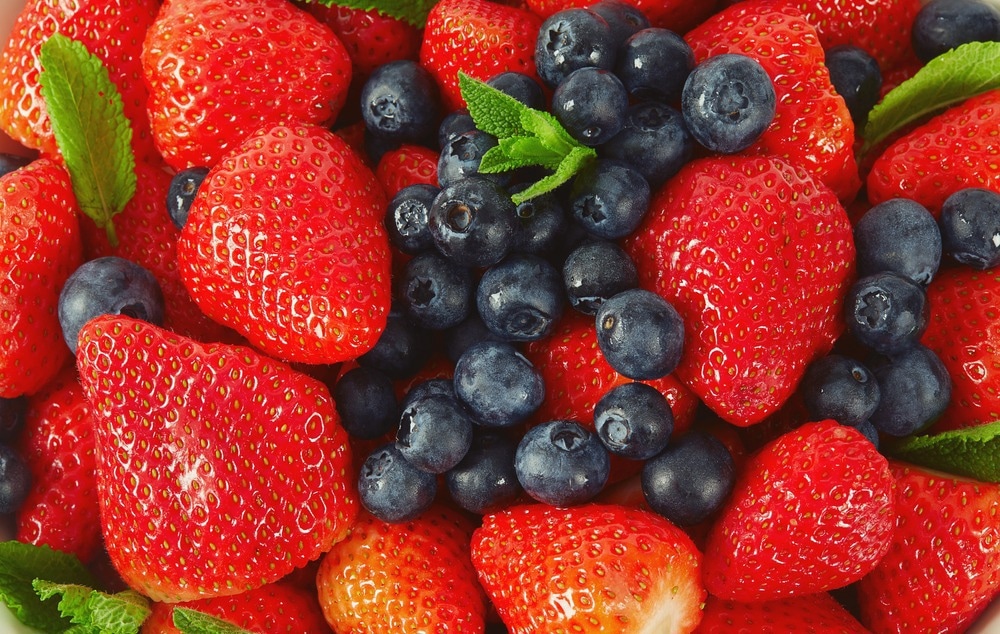 By Neha MathurReviewed by Danielle Ellis, B.Sc.Mar 7 2023
By Neha MathurReviewed by Danielle Ellis, B.Sc.Mar 7 2023In a recent study published in Environmental Research and Public Health, researchers evaluated whether polyphenol-rich strawberry and blueberry decoction-based functional beverages could prevent obesity or related metabolic alterations in high-fat and high-fructose (HFF) diet-fed rats.
 Study: Strawberry, Blueberry, and Strawberry-Blueberry Blend Beverages Prevent Hepatic Steatosis in Obese Rats by Modulating Key Genes Involved in Lipid Metabolism. Image Credit: Diana Taliun/Shutterstock
Study: Strawberry, Blueberry, and Strawberry-Blueberry Blend Beverages Prevent Hepatic Steatosis in Obese Rats by Modulating Key Genes Involved in Lipid Metabolism. Image Credit: Diana Taliun/Shutterstock
In addition, they tried identifying the polyphenol profile of their urinary metabolites and assessed whether they also have some health benefits.
Background
The market for functional beverages is growing globally at an unprecedented annual rate of 6% and could be a USD 156 billion market by 2026. Clearly, people are becoming health conscious and shifting their preference from carbonated hypercaloric dishes to healthier hydrating products with natural pigments and fewer sweetening agents.
Both strawberry and blueberry decoctions are rich in polyphenols, mainly anthocyanins. However, they have contrasting polyphenol profiles, with the former being rich in pelargonidin hexoside and having ellagitannins as a minor component. Contrasting, the latter is rich in four different types of hexoside compounds and have flavanols as a minor component. Thus, according to the authors, these decoctions with complementary profiles could help elaborate functional beverages.
About the study
In the present study, researchers supplemented HFF diet-fed rats with berry-based beverages for 18 weeks to measure its effect on the biometric and adipose tissue of rats. In addition, they evaluated how these berry-based beverages affected rats' insulin resistance parameters and their fecal, serum, and hepatic triglycerides.
Further, the team showed the effect of berry-based beverages on test animals' hepatic lipid metabolism, including crucial genes for de novo synthesis of fatty acids, β-oxidation, and intracellular transport. Finally, they performed a targeted metabolomic analysis of all test animals' urine samples. It helped them identify which polyphenol metabolites presented in urine after a daily supplementation of berry-based beverages in the long term.
Results
The strawberry and blueberry-based beverages developed in this study had a high content of polyphenols, mainly anthocyanins. Though pelargonidin hexoside was the primary polyphenol in the strawberry decoction, blueberry-based one was rich in several flavonoids, e.g., quercetin hexoside, which made their profiles contrasting and an apt fit for functional beverages.
Another observation was that the berry-based beverages used in this study did not protect against hyperinsulinemia, hyperglycemia, β-cell pancreatic damage, and insulin resistance in HFF-fed rats partly because of their relatively low polyphenol content. Conversely, they exerted a chronic anti-hypertriglyceridemic effect.
These beverages also reduced the accumulation of triglycerides in the liver, which together with obesity and insulin resistance, is known as metabolic-associated fatty liver disease (MAFLD). Wang et al. reported that delphinidin 3-O-glucoside and cyanidin 3-O-glucoside, two anthocyanins purified from wild blueberry and strawberry fruits, completely cleared hepatic triglycerides. Liu et al. also showed that the phenolic acid-rich blueberry fraction had a much more inhibitory effect on triglyceride accumulation than its anthocyanin-rich fraction.
MAFLD causes a disparity in the lipid metabolism pathways, e.g., the β-oxidation pathway responsible for the catabolism of fatty acids and de novo lipogenesis or fatty acid biosynthesis, besides fatty acids import and export in the liver. Accordingly, compared to control rats, HFF diet-fed rats developed a mild MAFLD. They accumulated lipid vacuoles within hepatocytes but showed no increases in hepatic injury markers, e.g., aspartate transaminase (AST), alanine aminotransferase (ALT), or alkaline phosphatase (ALP).
The researchers also noted that all berry-based beverages down-regulated fatty acid synthase (FASN) expression; however, a decoction elaborated with blueberries down-regulated acetyl-CoA carboxylase A (ACACA) expression compared to the control group. Both ACC and FAS regulate hepatic de novo lipogenesis facilitating the conversion of acetyl-CoA to malonyl-CoA and further to palmitate, which, in turn, helps with triglyceride synthesis. However, strawberry-based decoction supplementation decreased the hepatic accumulation of palmitic acid, which promote a transition from MAFLD to proinflammatory non-alcoholic steatohepatitis (NASH).
The strawberry and blueberry-based beverages and their blend up- or down-regulated different genes; however, all three reduced the accumulation of lipid vacuoles within the parenchymal liver cells. Notably, in animals fed with a diet enriched in polyphenol elaborated with soybean, rich in isoflavones, the urine had a high amount of apigenin glucuronide and hydroxydaidzein. The chemometric analysis, however, showed a similar urinary polyphenol metabolite profile for both groups. However, it also identified some discriminants, e.g., equol glucuronide was present only in the control group urine sample. Multivariate analysis showed that a 100% strawberry-based beverage resulted in the excretion of urolithin B glucuronide and methyl urolithin A. Intriguingly, food processing did not affect the formation of urolithins. The researchers did not identify anthocyanin metabolites in the urine of test animals in contrast to some previous studies.
Conclusions
To summarize, the berry fruit decoction-based beverages prevented HFF-diet-induced hypertriglyceridemia and hepatic steatosis in rats. They modulated key genes involved in fatty acid hepatic metabolism to exert these effects. Despite their diverse polyphenol profile, they exerted slightly lower preventive effects than single fruit-based beverages, most likely due to the complex interactions between polyphenols. Nonetheless, future in vivo studies should validate these results and elucidate antagonistic, additive, or synergetic interactions between polyphenols.
Journal reference:
- Sotelo-González, A. et al. (2023) "Strawberry, Blueberry, and Strawberry-Blueberry Blend Beverages Prevent Hepatic Steatosis in Obese Rats by Modulating Key Genes Involved in Lipid Metabolism", International Journal of Environmental Research and Public Health, 20(5), p. 4418. doi: 10.3390/ijerph20054418.